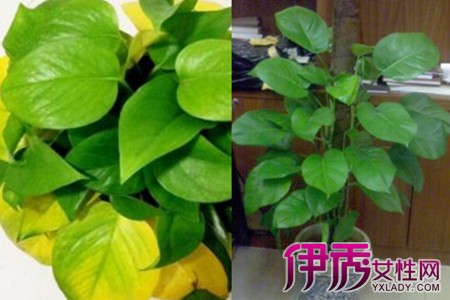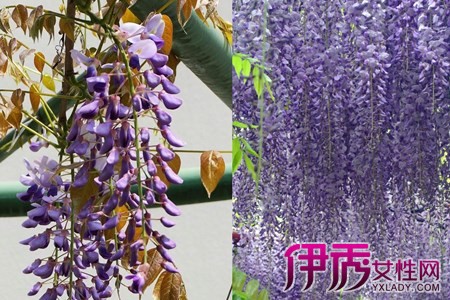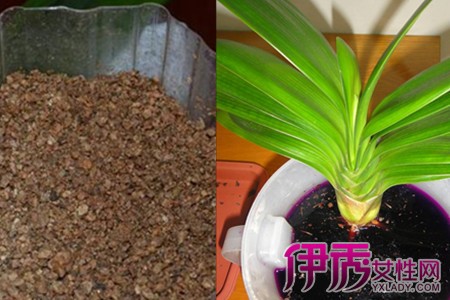Understand why green pineapple leaves turn yellow to keep domestic plants away from unhealthy conditions.

Green pineapple is a kind of flower that is easy to raise among all domestic flowers, but it sometimes becomes sick because of incorrect management. The yellowing or blackening and wilting of the leaves are all signs of its illness. Today we will tell you the various reasons and countermeasures that make the green apple leaves yellowing.
The reason for the yellowing of green apple leaves is lack of water. This kind of flower must be fully hydrated because it grows very fast and needs to be watered once a day in a dry room in winter. In summer, if you can water once a day in the rainy season, you can water them at least twice a day in the dry season. If you don't know the watering time, you can water them after you find the soil surface dry.
The second reason for the yellowing of green pineapple leaves: lack of light. Although green pineapple can grow without sunlight, it doesn't mean it doesn't need sunlight at all. They should be basked in the sun once or twice a week to ensure the health of green apple leaves. If you do not bask in the sun for a long time, the green pineapple leaves will turn yellow. If you want to solve this situation, you should give them proper exposure to the sun and remove the yellowing leaves so as not to disperse the nutrients.
The third reason for the yellowing of green apple leaves is that there is too much fertilizer. Green pineapple flowers also need to be fertilized, but don't give them too much fertilizer every time. The amount of fertilizer applied each time should be reduced and the number of times should be increased so that the leaves will not turn yellow. If the leaves are yellowed for this reason, you can remove the yellow leaves and change the soil for the green apple.
These are the reasons and treatment methods for the yellowing of green radish leaves. I hope they can help friends who have green pineapple at home. Green pineapple is a kind of plant that is very good for our indoor air and family health. as long as we cultivate it patiently, it will also give us more healthy returns.
Analysis of death causes and Rescue methods of Common domestic plants
I believe we have encountered this situation before. When buying potted plants, the florist always says, "it's best to raise this flower. Just water it." As a result, within a few months, the flower died "inexplicably". If you raise it well, why are you dead? Next, I would like to share with you some common causes of death of domestic plants and rescue methods.
1. Alocasia macrorrhiza
Alocasia macrorrhiza
Dripping Guanyin is a very pleasant name, but the dripping water is said to be poisonous, so be careful.
Common causes of death 1:
The light is too strong and the watering is inappropriate.
Main symptoms: fallen leaves, yellow leaves.
Solution: dripping Guanyin likes Yin, do not let the sun shine directly. Watering should be controlled in winter. Do not spray water on the leaves, which will cause white spots on the leaves.
Common causes of death 2:
There is not enough fertilizer and water.
Main symptoms: wilting leaves.
Solution:
Dishui Guanyin likes moist and fertile soil. During the growth period, more watering and topdressing can be done.
Tip: winter is the dormant period of dripping Guanyin. If the leaves shrink and turn yellow, you can cut off the leaves from the stem, stop watering and put them in the corner. You only need to water them once a month throughout the winter.
two。 Make a fortune tree
Make a fortune tree
Fortune Tree-when "Malaba Li" was renamed to "Wealth Tree", it immediately became the "town tree" of many small families.
Common causes of death:
The temperature is too low and there is water in the basin.
Main symptoms: leaf yellowing and shedding.
Solution:
The rich tree is easy to die when it is below 10 ℃. Avoid stagnant water in the basin and reduce watering in winter. During the growth period, you can often spray a small amount of water on the leaf surface.
Tip: the rich tree is sunny and shady. It can be placed in a place with weak indoor light for 2-4 weeks, and then in a place with strong light.
3. Green pineapple
Green pineapple
Green Luo-up to the White House, down to the people's rooms, all have its green posture.
Common causes of death 1:
It's not watered properly.
Main symptoms: leaf yellowing.
Solution: green pineapple likes hot and humid environment. The basin soil is moist, and when it is found to be white, it can be watered through. Reduce watering in winter and keep the basin soil dry.
Common causes of death 2:
The light is uncomfortable.
Main symptoms: leaves yellowing and withering.
Solution:
Green pineapple is suitable for "semi-overcast" and avoid direct sunlight, but it can not be placed in the shade for a long time, and it can be maintained in full sun when the temperature is low in winter.
Tip: in midsummer, you can spray water to the air root and leaf surface several times a day, not only clean the leaves, but also reduce the leaf temperature and increase the humidity of the small environment.
4. Aloe
Aloe
Aloe can absorb harmful gases such as formaldehyde, which is a must for a new home.
Common causes of death 1:
Frostbite
Main symptoms: blackening of leaves.
Solution: aloe vera is a tropical plant, naturally afraid of cold, the temperature is below 0 ℃, the water in the leaves will freeze. When the temperature gradually drops below 5 ℃, it should be moved indoors to the south to shelter from the wind and the sun.
Common causes of death 2:
It's overwatered.
Main symptoms: rootstock rot.
Solution: although it looks full of water, the most important thing to maintain aloe is not to have too much water. Usually spray or spray water on the leaves and keep them slightly wet. Keep the soil dry in winter.
Tip: potted aloe had better use mud pots, not porcelain pots and plastic pots.
5. Asparagus asparagus
Asparagus asparagus
Asparagus-very ordinary, unique elegant style, the first choice for literati.
Common causes of death 1:
Improperly placed.
Main symptoms: branches and leaves yellowing and withering.
Solution: asparagus can not be exposed to the sun, but to be able to see the sun, ventilation; it is best to stay away from the stove and TV, the room temperature can not be less than 5 ℃.
Common causes of death 2:
It's overwatered.
Main symptoms: rootstock rot.
Solution: asparagus should be watered thoroughly when it is dry, but no stagnant water can be left in the basin.
Tip: if asparagus withered due to improper placement, cut off the withered leaves, continue to maintain, and send out new buds.
6. Hanging orchid
Hanging orchid
Cymbidium-- A popular "grassroots" orchid
Common causes of death:
Improperly placed.
Main symptom: withering of leaf tip
Solution:
The orchid should be placed in a place with short sunshine or no direct sunlight to avoid strong light. Avoid direct contact with walls, iron frames, window frames and other buildings. The leaves of Cymbidium should be washed and kept fresh in time, and the withered leaves should be cut off frequently.
7. Rubber tree
Rubber tree
Rubber tree-- A plant that seems to have a long life, of course, depends on the level of the owner.
Common causes of death:
The temperature is too low.
Main symptoms: blackening and shedding of leaves and rot of roots.
Solution: bark trees like the sun, not cold-resistant, in winter to move into the indoor sunny place, keep the room temperature above 10 ℃, the minimum temperature should not be lower than 5 ℃. Move outside or on the balcony for maintenance from the end of April to the beginning of May next year.
Tip: when it is hot in summer, rubber trees grow faster and can be fattened and watered.
8. Cyclamen
Cyclamen
Cyclamen, a world-class famous flower, is said to be easy to raise, but there are numerous negative examples around.
Common causes of death 1:
Directly spray petals when watering
Main symptoms: rotten roots, petals rot
Solution:
It is best to use the basin bottom immersion method to water, wait for flowers and leaves wilting slightly before watering. Don't spray water on the petals, they will rot.
Common causes of death 2:
It's not ventilated.
Main symptoms: petals are dry and withered.
Solution:
Cyclamen likes ventilation, smoke and dirty air will make the petals dry and wither, but they can not be placed directly in the tuyere.
Tip: cyclamen should be placed in windows, balconies and other places with sufficient light, and often change the position of flowerpots. Plenty of light can make the flowers more beautiful and the leaves more shiny.
9. Cactus
Cactus
Cactus-this can also be fed to death, it is really a divine man!
Common causes of death 1:
The flowerpot is too big.
Main symptom: root rot.
Solution:
The flowerpot should not be too big, so that it can hold the sphere and have a little gap. The flowerpot is too large to be absorbed after pouring enough water, and the air in the pot is impassable, which is easy to make the root rot.
Common causes of death 2:
Excessive or insufficient watering.
Main symptoms: spherical decay.
Solution:
Watering should be controlled in the morning on sunny days in winter. Summer season should be fully watered in the morning and evening, and watering at noon is easy to cause ball burns.
Tip: for those cactus with sunken tops, be careful not to pour water into the depressions so as not to cause decay.
10. Rieger Begonia
Rieger Begonia
Rieger Begonia, a popular New year flower in recent years, has a long flowering period.
Common causes of death 1:
The temperature is uncomfortable.
Main symptom: the leaf color turns yellow.
Solution:
The optimum temperature of Rieger Begonia is 18 ℃-22 ℃. Put it indoors facing south and sun as far as possible in winter. When there is a hot weather lasting more than 28 ℃ in summer, you can put it in an air-conditioned room or shade.
Common causes of death 2:
It's not watered properly.
Main symptoms: wilting, withering.
Solution:
Pot soil should be kept moist, not dry and too wet; flowering should not be too much, otherwise it is easy to fall flowers.
Tip: Rieger Begonia requires sufficient fat and water during its growing season. Soak soaking liquid or fermented rice panning water can be used every two weeks.
Conclusion: there are many potted plants suitable for domestic cultivation, so we won't list them one by one here. As long as you take a little more care of them, it is not difficult for them to thrive away from disease.
Are your plants always easy to die? Learn these tricks!
If the plants in your home are always easy to die and can be kept for no more than three months, then you need to learn these maintenance tips!
Plant rotting roots can use the following tips:
Shredded tile
The soil in the flowerpot is lack of nutrients, dry and hard, which can easily block the drainage hole at the bottom of the flowerpot. And affect the normal growth of plants. Therefore, potted plants need to loosen the soil in time and increase the permeability of the soil. We can go outside and find some light old bricks and tiles, crush them and spread them at the bottom of the flowerpot, which can play the function of ventilation and ventilation, so that we can smoothly drain and dehumidify without too much loosening soil, and we no longer worry about stagnant water and rotting roots.
Loofah collaterals
Don't throw away the loofah that we usually use to wash dishes, cut it into small pieces and put it in a flowerpot, and then fill it with soil to grow flowers. Nothing is more water-absorbing and breathable than loofah, which is used to grow flowers and green plants, the soil is not easy to dry and deteriorate, and the loofah will become a natural nitrogen fertilizer after decomposition. Plants grow stronger and stronger, and they will soon be able to raise and explode pots, which is simply a sharp weapon for plant conservation and can turn waste into treasure.
Tips for preventing yellow leaves:
Rice vinegar
The green pineapple raised by water at home and the leaves of the rich tree turn yellow, how to save it? With the rice vinegar in the kitchen, the leaves will soon turn green. Rice vinegar is rich in amino acids and a variety of vitamins. You can dilute the rice vinegar according to 1RU 1000, wipe both sides of the leaf, and then scrub it with clean water. This allows the leaves to absorb the nutrients and make them bright and shiny. Before the flowers and plants bloom, spraying some rice vinegar on the flower bracts can also make the flowers bloom more vigorously.
Expired milk yogurt
If the leaves of your plants turn yellow, it is likely to be a lack of nutrients. Do not throw away the expired milk, put it in a bottle and put it in a bright place to ferment for a week or so, it will become a good nitrogen fertilizer, diluted with water to water the flowers, so that the flowers can also "drink" enough nutrients.
Here is a great way to prevent pests:
Sesame oil
Summer is a time of high incidence of insect pests, domestic flowers and plants, sometimes inevitably appear ants, aphids and other insect pests, not only harmful to flowers and plants, but also easy to invade the human body, not conducive to health. To prevent insects such as ants and spiders, you only need to put some sesame oil on the edge of the flowerpot to disperse the insects and keep them away from plants.
Garlic
We all know that garlic can resist bacteria and reduce inflammation, which can not only enhance the resistance of the human body, but also enhance the pest prevention ability of flowers and plants. Peel and mash the garlic, crush it into minced garlic, then dig a small hole in the flowerpot and bury it in the soil to prevent ants and snails.
- Prev

How to plant the seeds of wisteria to produce more beautiful flowers
Fresh and elegant flowers and green plants always give people a sense of tranquility and elegance. Appreciate these beautiful plants, but also have the role of edifying the body and mind. Wisteria is a kind of garden plant planted in large areas. This kind of flower smells fragrant.
- Next

How to deal with the rotten root of the gentleman orchid? the little trick can be solved easily.
When raising magnolia, there will be rotten roots, and if it is not dealt with in time, there is the possibility of death. The rotting roots of Cymbidium are mostly caused by excessive watering, high temperature of growth environment, too thick fertilization and so on. So how to deal with the rotten root of the gentleman orchid?
Related
- Fuxing push coffee new agricultural production and marketing class: lack of small-scale processing plants
- Jujube rice field leisure farm deep ploughing Yilan for five years to create a space for organic food and play
- Nongyu Farm-A trial of organic papaya for brave women with advanced technology
- Four points for attention in the prevention and control of diseases and insect pests of edible fungi
- How to add nutrient solution to Edible Fungi
- Is there any good way to control edible fungus mites?
- Open Inoculation Technology of Edible Fungi
- Is there any clever way to use fertilizer for edible fungus in winter?
- What agents are used to kill the pathogens of edible fungi in the mushroom shed?
- Rapid drying of Edible Fungi

